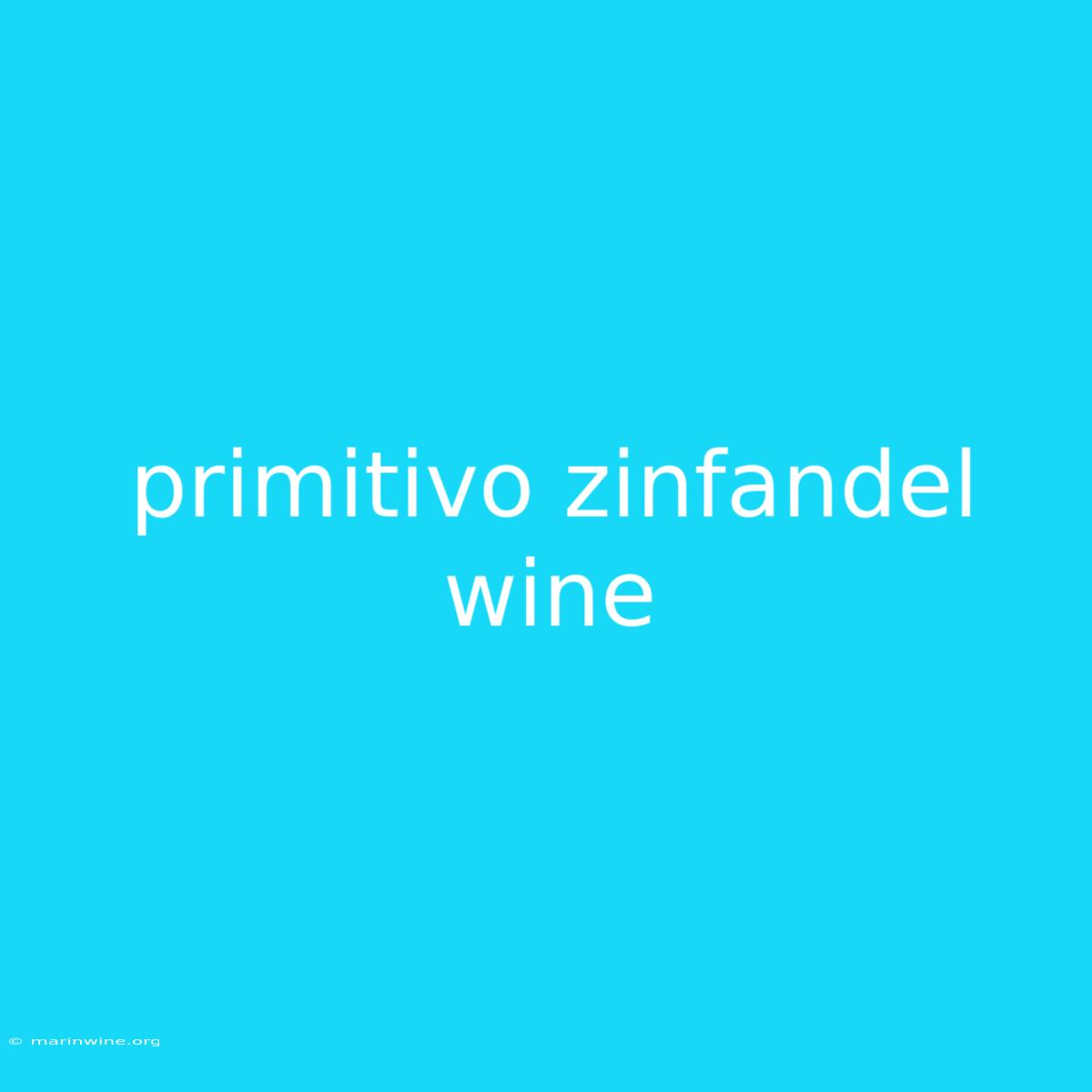Primitivo vs. Zinfandel: Unveiling the Secrets of Two Wine World Titans
Have you ever wondered why Primitivo and Zinfandel taste so similar, yet are considered different grapes? It's a question that has puzzled wine enthusiasts for years. This article delves into the captivating world of these two powerhouse grapes, exploring their unique origins, flavor profiles, and the intriguing connection that binds them.
Why This Matters: Understanding the nuances of Primitivo and Zinfandel can significantly enhance your wine appreciation. It unlocks a world of flavor, enabling you to confidently choose the perfect bottle for any occasion. This article serves as your guide to navigating the complexities of these two beloved varietals.
Key Takeaways of Primitivo & Zinfandel:
| Feature | Primitivo | Zinfandel |
|---|---|---|
| Origin | Southern Italy | California, USA |
| Flavor Profile | Bold, Jammy, Spicy | Rich, Fruity, Peppery |
| Alcohol | High (14%-16%) | High (14%-16%) |
| Food Pairing | Spicy Dishes, Red Meats | BBQ, Pizza, Grilled Foods |
Primitivo: The Italian Powerhouse
Primitivo, meaning "primitive" in Italian, refers to the early ripening nature of this grape. It thrives in the warm, sunny climate of Southern Italy, particularly in Puglia. Its deep purple color and intense aromas hint at the robust flavors that lie within.
Key Aspects of Primitivo:
- Intense Fruitiness: Primitivo wines often showcase a vibrant fruit profile, brimming with notes of blackberries, plums, and cherries.
- Spicy Complexity: Expect a spicy kick with hints of black pepper, cloves, and cinnamon, adding depth and complexity to the flavor profile.
- Full-bodied Texture: Primitivo wines are known for their full-bodied structure, offering a rich and velvety mouthfeel.
- High Alcohol Content: The warm climate fosters high sugar levels, resulting in wines with a considerable alcohol content, typically between 14% and 16%.
Zinfandel: The Californian Legend
Zinfandel, a name derived from the German word "Zierfandler," is considered an American icon, particularly in California. This grape thrives in the state's diverse climates, yielding a spectrum of styles from light and fruity to bold and concentrated.
Key Aspects of Zinfandel:
- Fruity Explosion: Zinfandel wines burst with flavors of red and black fruits like raspberries, blackberries, and even notes of strawberry jam.
- Floral and Spicy Nuances: Aromas of violets and hints of peppercorn contribute to its complex flavor profile.
- Varied Styles: Zinfandel wines come in a range of styles, from lighter-bodied, fruit-forward wines to rich, full-bodied, and jammy expressions.
- High Alcohol Content: Similar to Primitivo, Zinfandel wines have a high alcohol content, often reaching 14% to 16%.
The Primitivo-Zinfandel Connection
The fascinating connection between these two grapes lies in their genetic link. It's believed that Primitivo is actually a clone of Zinfandel, though there are some subtle differences. Their origins can be traced back to the same Croatian grape, known as "Crljenak Kaštelanski."
These differences might be due to:
- Clonal variations: Over time, mutations and selections may have led to subtle differences in the grapes' chemical composition.
- Terroir and Winemaking: The unique soil and climate conditions of Italy and California, coupled with distinct winemaking practices, also play a role in shaping the final wines.
FAQ: Primitivo & Zinfandel
Here are some frequently asked questions about these two iconic grapes:
Q: Which one should I try first? A: Both Primitivo and Zinfandel offer delicious experiences. For a bold, fruity, and spicy wine, start with Primitivo. If you prefer a slightly lighter style with notes of pepper and spice, try Zinfandel.
Q: What food pairs well with these wines? A: Both grapes are ideal with spicy dishes, BBQ, red meats, grilled foods, and pizza.
Q: Are there any specific producers to look for? A: For Primitivo, try wines from the Puglia region, such as Tormaresca or Feudi di San Marzano. For Zinfandel, explore the offerings of Ridge Vineyards, Zaca Mesa Winery, and Seghesio Family Vineyards.
Q: Can I find Primitivo and Zinfandel wines in my local store? A: Primitivo and Zinfandel wines are widely available in most wine shops and supermarkets. Check out the international sections for Primitivo and look for the "Zinfandel" label for California-produced wines.
Tips for Choosing Primitivo & Zinfandel Wines:
- Read the label carefully: Look for "Primitivo" for Italian wines and "Zinfandel" for American wines.
- Pay attention to the region: Wines from the Puglia region in Italy are generally bolder and more intense.
- Consider the producer: Reputable producers often have a consistent style, so research their reputation before purchasing.
- Taste before you buy: If you can, sample a few different wines to find your preferred style and flavor profile.
Summary of Primitivo & Zinfandel:
This exploration of Primitivo and Zinfandel unveils the fascinating story of two closely related grapes that deliver distinctly delicious experiences. From the bold, fruit-forward character of Primitivo to the diverse styles of Zinfandel, these grapes continue to capture the hearts of wine enthusiasts worldwide.
Embrace the adventure of discovering these powerful varietals. Let your taste buds journey through the captivating world of Primitivo and Zinfandel, and find your new favorite wine.

